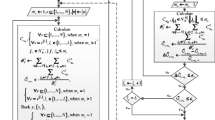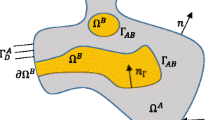Abstract
Treatment of uncertainties in structural design involves identifying the boundaries of the failure domain to estimate reliability. When the structural responses are discontinuous or highly nonlinear, the failure regions tend to be an island in the design space. The boundaries of these islands are to be approximated to estimate reliability and perform optimization. This work proposes Alpha (α) shapes, a computational geometry technique to approximate such boundaries. The α shapes are simple to construct and only require Delaunay Tessellation. Once the boundaries are approximated based on responses sampled in a design space, a computationally efficient ray shooting algorithm is used to estimate the reliability without any additional simulations. The proposed approach is successfully used to decompose the design space and perform Reliability based Design Optimization of a tube impacting a rigid wall and a tuned mass damper.




















Similar content being viewed by others
References
Acar E (2013) Effects of the correlation model, the trend model, and the number of training points on the accuracy of kriging metamodels. Expert Syst 30:418–428
Attali D, Boissonnat JD, Lieutier A (2003) Complexity of the Delaunay triangulation of points on surfaces: the smooth case. Proc 19th Ann Sympos Comput Geom, 201–210
Au KS, Beck JL (2001) Estimation of small failure probabilities in high dimensions by subset simulation. Probab Eng Mech 16:263–277
Basudhar A, Missoum S (2008) Adaptive explicit decision functions for probabilistic design and optimization using support vector machines. Comput Struct 86:1904–1917
Basudhar A, Missoum S (2009) Local update of support vector machine decision boundaries. 50th AIAA/ASME/ASCE/AHS/ASC structures, structural dynamics, and materials conference
Basudhar A, Missoum S (2010) An improved adaptive sampling scheme for the construction of explicit boundaries. Struct Multidiscip Optim 42:517–529
Basudhar A, Missoum S, Sanchez AH (2008) Limit state function identification using support vector machines for discontinuous responses and disjoint failure domains. Probab Eng Mech 23:1–11
Basudhar A, Dribusch C, Lacaze S, Missoum S (2012) Constrained efficient global optimization with probabilistic support vector machines. Struct Multidiscip Optim 46:201–221
Chen S, Nikolaidis E, Cudney HH (1999) Comparison of probabilistic and fuzzy set methods for designing under uncertainty. Proceedings, AIAA/ASME/ASCE/AHS/ASC structures, structural dynamics, and materials conference and exhibit. 2860–2874
de Berg M (1993) Ray shooting, depth orders and hidden surface removal. Lecture notes in computer science, vol 703. Springer, New York
de Freitas N, Milo M, Clarkson P, Niranjan M, Gee A (1999) Sequential support vector machines. In neural networks for signal processing IX—Proceedings of the 1999 I.E. Signal processing society workshop
Dribusch C, Missoum S, Beran P (2010) Amultifidelity approach for the construction of explicit decision boundaries: application to aeroelasticity. Struct Multidiscip Optim 42:693–705
Dwyer RA (1988) Average-case analysis of algorithms for convex hulls and Voronoi diagrams. Ph. D. thesis, Report CMU-CS-88-132, Carnegie-Mellon Univ., Pittsburgh, Pennsylvania
Ebeida, MS, Mitchell SA, Awad MA, Park C, Swiler LP, Manocha D and Wei LY (2014). Spoke Darts for Efficient High Dimensional Blue Noise Sampling. arXiv:1408.1118.
Edelsbrunner H (2010) Alpha shapes-a survey. Tessellations in the Sciences 27
Edelsbrunner H, Ernst PM (1994) Three-dimensional alpha shapes. ACM Trans Graph 13:43–72
Edelsbrunner H, Kirkpatric DG, Seidal R (1983) On the shape of a set of points in the plane. IEEE Trans Inf Theory 29:551–559
Fonseca JR, Friswell MI, Lees AW (2007) Efficient robust design via Monte Carlo sample reweighting. Int J Numer Methods Eng 69:2279–2301
Ganapathy H, Ramu P (2013) A low discrepancy sampling strategy and alpha shapes for design space decomposition in reliability studies, First Indian Conference in Applied Mechanics 2013, Chennai, India
Goel T, Haftka RT, Shyy W, Watson LT (2008) Pitfalls of using a single criterion for selecting experimental designs. Int J Numer Methods Eng 75:127–155
Gu L (2001) A comparison of polynomial based regression models in vehicle safety analysis. ASME Design engineering technical conferences – design automation conference, Pittsburgh
Haldar A, Farag R (2010) A novel reliability evaluation method for large dynamic engineering systems. 2nd International conference on reliability, safety and hazard
Hao HY, Qiu HB, Chen ZZ, Xiong HD (2012) Reliability analysis method based on support vector machinesclassification and adaptive sampling strategy. Adv Mater Res 544:212–217
Hormann K, Agathos A (2001) The point in polygon problem for arbitrary polygons. Comput Geom 20:131–144
Jiang P, Basudhar A, Missoum S (2011) Reliability assessment with correlated variables using support vector machines, 52nd AIAA/ASME/ASCE/AHS/ASC structures, structural dynamics and materials conference proceedings
Kalos SL, Marton G (1998) Worst-case versus average case complexity of ray-shooting. Computing 61:103–131
Kim HC, Pang S, Je HM, Kim D, Yang BS (2003) Constructing support vector machine ensemble. Pattern Recogn 36:2757–2767
Kleijnen JPC, Rubinstein RY (1996) Optimization and sensitivity analysis of computer simulation models by the score function method. Eur J Oper Res 88:1–15
Kutaran H, Eskandarian A, Marzougui D, Bedewi NE (2002) Crashworthiness design optimization using successive response surface approximations. Comput Mech 29:409–421
Lacaze S, Missoum S (2013) Reliability-based design optimization using kriging and support vector machines. Proceedings of the 11th International conference on structural safety & reliability, New York
Lee I, Choi KK, Noh Y, Zhao L, Gorsich D (2011) Sampling-based stochastic sensitivity analysis using score functions for RBDO problems with correlated random variables. J Mech Des 133(2):21003
Lin K, Basudhar A, Missoum S (2013) Parallel construction of explicit boundaries using support vector machines. Eng Comput 30:132–148
Lin SP, Shi L, Yang RJ (2014) An alternative stochastic sensitivity analysis method for RBDO. Struct Multidiscip Optim 49(4):569–576
Mandal DP, Murthy CA (1997) Selection of alpha for alpha-hull in R2. Pattern Recogn 30:1759–1767
Melchers RE (1999) Structural reliability analysis and prediction. Wiley, New York
Missoum S, Benchaabane S, Sudret B (2004) Handling bifurcations in the optimal design of transient dynamic problems. 45th AIAA/ASME/ASC/AHS/ASC structures, structural dynamics and materials conference, Palm Springs, CA
Missoum S, Ramu P, Haftka RT (2007) A convex hull approach for the reliability-based design optimization of nonlinear transient dynamic problems. Comput Methods Appl Mech Eng 196:2895–2906
Packer E, Tzadok A, Kluzner V (2011) Alpha-shape based classification with applications to optical character recognition. International conference on document analysis and recognition
Ramu P, Krishna M (2012) A variable-fidelity and convex hull approach for limit state identification and reliability estimates. 12th AIAA Aviation technology, integration, and operations (ATIO) and 14th AIAA/ISSMO Multidisciplinary Analysis and Optimization Conference, Indianapolis, Indiana
Ramu P, Kim NH, Haftka RT (2008) Error amplification in failure probability estimates of small errors in response surface approximations. Trans Soc Automot Eng 116:182–193
Sobieszczanski SJ, Kodiyalam S, Yang RJ (2001) Optimization of car body under constraints of noise, vibration, and harshness (NVH), and crash. Struct Multidiscip Optim 22:295–306
Song H, Choi KK, Lee I, Zhao L, Lamb D (2013) Adaptive virtual support vector machine for reliability analysis of high-dimensional problems. Struct Multidiscip Optim 47(4):479–491
Valdebenito MA, Schuëller GI (2010) A survey on approaches for reliability-based optimization. Struct Multidiscip Optim 42(5):645–663
Viana FAC (2011) Surrogates toolbox user’s guide, Gainesville, FL, USA, Version 3.0 ed, available at https://sites.google.com/site/srgtstoolbox
Wilson JA, Bender A, Kaya T, Clemons PA (2009) Alpha shapes applied to molecular shape characterization exhibit novel properties compared to established shape descriptors. J Chem Inf Model 49:2231–2241
Yang IT, Hsieh YH (2013) Reliability-based design optimization with cooperation between support vector machine and particle swarm optimization. Eng Comput 29(2):151–163
Youn BD, Choi KK (2004) An investigation of nonlinearity of reliability-based design optimization approaches. Mech Des 126(3):403–411
Zhang W, King I (2002) A study of the relationship between support vector machine and gabriel graph, International Joint Conference on Neural Networks
Ziegler GM (1995) Lectures on polytopes. Springer, New York
Acknowledgments
Thanks are due to members of the CAD lab and Mr. Sivashankar, Department of Engineering Design, IIT Madras. The authors thank Professor Samy Missoum, University of Arizona and Dr. Anirban Basudhar, Livermore Software Technology Corporation for their comments and suggestions. The authors thank Mr. Ryan Asher John for help with the simulations. Support from IIT Madras for the summer fellowship program is appreciated here. Mr. Harish Ganapathy worked on this paper in one such fellowship during his undergraduate study at SCSVMV University, Kanchipuram, India.
Author information
Authors and Affiliations
Corresponding author
Appendix A: error metrics
Appendix A: error metrics
-
1.
R2:
The coefficient of multiple determinations is defined as:
$$ {R}^2=1-\frac{{\displaystyle \sum_{i=1}^n{\left({y}_i-{\widehat{y}}_i\right)}^2}}{{\displaystyle \sum_{i=1}^n{\left({y}_i-\overline{y}\right)}^2}} $$(A.1)where y i is the actual value at the i th design point, ŷ i is the predicted value at the i th design point, and \( \overline{y} \) the mean of the actual response. R 2 is a measure of the amount of reduction in the variability of y obtained by using the response surface. 0 ≤ R 2 ≤ 1. A larger value of R 2 is desirable for a good response surface. But, a larger R 2 does not necessarily guarantee a good response surface. Thus, this estimate should be used in conjunction with other error estimates to gauge the quality of the response surface. R 2 continuously increases with addition of terms irrespective of whether the additional term is statistically significant.
-
2.
Adjusted R2:
The adjusted coefficient of multiple determinations is defined as
$$ {R}_{adj}^2=1-\frac{n-1}{n-p}\left(1-{R}^2\right) $$(A.2)where n is the number of design points, and p is the number of regression coefficients.
Unlike R 2, R 2 adj decreases when unnecessary terms are added. Hence, R 2 adj along with R 2 can be used to comment on the quality of response surface and the presence of unnecessary terms in the response surface.
-
3.
Root-Mean-Square Error (RMSE):
The root-mean-square error, RMSE, and the predicted RMS errors are defined, respectively, as
$$ \mathrm{R}\mathrm{M}\mathrm{S}=\sqrt{\frac{{\displaystyle \sum_{i=1}^n{\left({y}_i-{\widehat{y}}_i\right)}^2}}{n}} $$(A.3) -
4.
Prediction Error Sum of Squares (PRESS):
The prediction error sum of squares provides error scaling. To estimate the PRESS, an observation is removed at a time and a new response surface is fitted to the remaining observations. The new response surface is used to predict the withheld observation. The difference between the withheld observation and the computed response value gives the PRESS residual for that observation. This process is repeated for all the observations and the PRESS statistic is defined as the sum of the squares of the n PRESS residuals. When polynomial response surfaces are used, the repetitive estimate of PRESS residuals can be obviated by using the following expression:
$$ \mathrm{PRESS}={{\displaystyle \sum_{i=1}^n\left(\frac{e_i}{1-{E}_{ii}}\right)}}^2 $$(A.4)where E = X(X T X)− 1 X T and X is the Grammian matrix (ŷ = Xb), and b is the coefficient vector. Data points at which E ii are large will have large PRESS residuals. These observations are considered high influence points. That is, a large difference between the ordinary residual and the PRESS residual will indicate a point where the model fits the data well, but the model built without that point has a poor prediction. A RMS version of PRESS allows us to compare the PRESS_RMS with the RMS errors. This permits us to explore the influence that few points might have on the entire fit. The PRESS_RMS is expressed as:
$$ \mathrm{PRESS}\_\mathrm{R}\mathrm{M}\mathrm{S}=\sqrt{\frac{\mathrm{PRESS}}{n}} $$(A.5)PRESS can be used to estimate an approximate R 2 for prediction as:
$$ {R}_{pred}^2=1-\frac{PRESS}{{\displaystyle \sum_{i=1}^n{\left({y}_i-\overset{\_}{y}\right)}^2}} $$(A.6)The denominator in (A.6) is referred to as total sum of the squares.
Rights and permissions
About this article
Cite this article
Ganapathy, H., Ramu, P. & Muthuganapathy, R. Alpha shape based design space decomposition for island failure regions in reliability based design. Struct Multidisc Optim 52, 121–136 (2015). https://doi.org/10.1007/s00158-014-1224-6
Received:
Revised:
Accepted:
Published:
Issue Date:
DOI: https://doi.org/10.1007/s00158-014-1224-6




